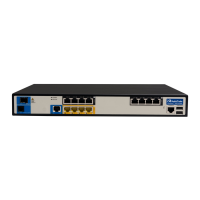Reference Guide 628 Document #: LTRT-17939
Mediant MSBR
75.2 Data Routing Commands
Each routing protocol is available only if it is included in the Feature key supplied with the
system.
Border Gateway Protocol (BGP) is the main routing protocol of the Internet. It is used to
distribute routing information among Autonomous Systems. (For more information, refer to
the protocol's RFC at http://www.ietf.org/rfc/rfc1771.txt).
Open Shortest Path First Protocol (OSPF) is an Interior Gateway Protocol (IGP) used to
distribute routing information within a single Autonomous System. (For more information,
refer to the protocol's RFC at http://www.ietf.org/rfc/rfc2328.txt.)
The feature's routing engine is based on the Quagga GNU routing software package. By
using the BGP and OSPF protocols, this routing engine enables the device to exchange
routing information with other routers within and outside an Autonomous System.
75.2.1 Static Routing Commands
Static Routing occurs when the router uses pre-defined, user-configured routing entries to
forward traffic. Static routes are usually manually configured by the network administrator
and added to the routing table.
A common use of static routes is for providing an instruction on how to forward traffic when
no other route exists.
Static routes have a much lower administrative distance in the system than the dynamic
routing protocols, and in most scenarios are prioritized over the dynamic routes.
75.2.1.1 ip route ip address
This command configures routing rules.
Syntax
ip route <ip address> <ip destination mask> [next-hop ip address]
<interface> <interface ID> [<metric value>] [track <track id>]
[bfd-neighbor <neighbor ID>] [output-vrf <vrf_id>] [description
<string>]
Command Description
ip address Defines IP Destination prefix in the format of a.b.c.d.
ip destination mask Defines the IP Destination prefix mask.
interface Defines source interface name and id.
metric Defines the metric (priority) value for this route (0-255).
next-hop Defines the next hop for routing
track Defines the track to be used for this route.
output-vrf Defines the output vrf name for route leaking between vrfs.
bfd-neighbor Defines the ID of a BFD neighbor to attach the route to.
desciption Define a description name for this route

